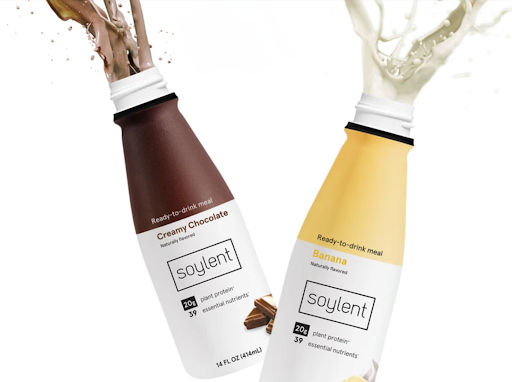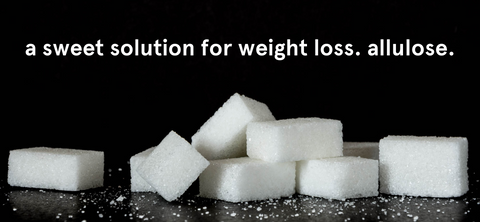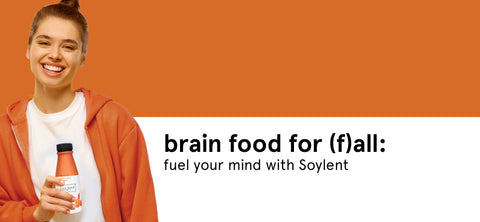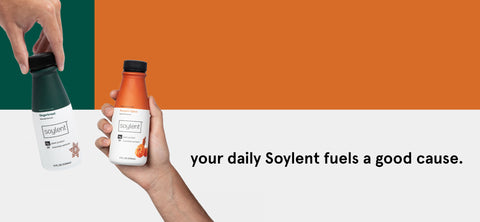
At Soylent, we are committed to bringing to market the best tasting products using the most technologically advanced ingredients. Allulose is the latest in sweetener technology and after decades of research and years of success in the Japanese market, Allulose is now gaining traction in the US and is the latest addition to our drink formulas.
Allulose is a naturally occurring, low-calorie carbohydrate that offers the taste and mouthfeel of sugar with much less calories. It is not considered an added sugar and does not contribute to net carbs. Allulose is 70% as sweet as sugar, but contains only 0.4 calories per gram compared to 4 calories per gram for sugar. It is safe to consume and does not lead to cavities like other carbohydrates.1-3 Allulose is not a sugar alcohol (which are often used as low calorie carbohydrates, but can cause digestive distress) and can naturally be found in figs, raisins, molasses, and maple syrup. It can also be made through fermentation of several sources of carbohydrates which is a much more sustainable way to produce this ingredient. The allulose in our drinks is made through fermentation.
More importantly, allulose does not raise blood glucose or insulin levels in healthy individuals or when consumed by people with type 2 diabetes.4-10 This latest attribute made allulose an interesting choice for Soylent to maintain the low glycemic (GI) index of our drinks while maintaining a high level of nutrient density and delivering a great taste.
Why is maintaining a low GI (glycemic index) important for Soylent?
The body’s glycemic response after a meal dictates the blood glucose level. A lower glycemic response corresponds to less insulin released, better long-term blood glucose control and a reduction in blood lipids, all leading to better health outcomes. The glycemic response is affected by how much carbohydrates were consumed but also by their glycemic index.11, 12 High GI carbs will raise blood glucose level faster than low GI carbs. Fat and protein slow our digestion and therefore serve to lower the glycemic response to carbohydrates when consumed together. High GI carbs have their place since they can be useful during exercising to provide immediate energy or when blood glucose is low but generally an overall low GI diet is recommended hence why Soylent products are formulated to a low GI Index.13
As part of our deep dive on assessing the fit of allulose for our formulas, we caught up with Professor John Sievenpiper, a carbohydrate expert and Associate Professor at the Department of Nutritional Sciences at the University of Toronto and a clinical physician at St Michael’s Hospital.
Soylent: You have focused your work on the impact of nutrition on cardiometabolic diseases, what motivated you to focus on that field specifically?
Prof Sievenpiper: A lot of the questions that my team looks to answer through research come from clinical frustrations working with patients. I treat patients with cardiometabolic diseases and sometimes I dont have the answers to help my patients or I dont have the tools to get my patient’s buy-in to dietary recommendations. Diet and nutrition are the cornerstone of therapy and although everybody agrees with this, clinical practice, research funding and government policies do not reflect this and so my work is focused on changing policy so that nutrition gets the place it deserves.
“Diet and nutrition are the cornerstone of therapy”
Soylent: Why did you choose to focus some of your research efforts on allulose?
Prof Sievenpiper: Our lab was interested in the impact of caloric sugars on health through their metabolic effects and their effects on hormones. A lot of our work was focused on fructose's impact on metabolism since as surprising as it may sound, fructose was identified at the turn of the century as a potential alternative sugar for people with diabetes since it has a lower glycemic index than glucose. Interestingly, it was shown to have a catalytic effect whereby it lowered the glycemic response of higher GI carbohydrates like glucose. I then became interested in looking for other carbohydrates that could also have a catalytic effect on high GI carbs but also have lower calories. I looked to epimers of fructose like tagatose, sorbose and allulose and realized that they also share that catalytic effect. What was interesting about allulose was that not only did it have the same catalytic effects as fructose, meaning it lowered the body’s glycemic response to higher GI carbs but it also had lower calories and it shared a lot of the functional and sensory benefits of sugar in terms of taste and mouthfeel.
“Allulose lowers the body’s response to other high GI carbohydrates”
Soylent: Allulose has shown some promise in reducing the glycemic response to carbohydrates after a meal but results in healthy individuals were mixed (some studies conclusive others not). Certainly this effect would be beneficial for people with diabetes but does allulose offer advantages for healthy individuals?
Prof Sievenpiper: In our trials, the beneficial glycemic response to allulose was seen in people with diabetes but not in healthy individuals. The effect was larger in healthy individuals but not significant because we saw a lot of variability. It is also typically harder to measure the glycemic response of healthy individuals since their response is typically weaker. However, in a systematic review that we have recently published, we highlighted that there appears to be a benefit for allulose across glycemic status (diabetes, pre diabetes, healthy individuals). In any case, given that the portion of the global population having metabolic syndrome is reaching 25% and 10% of the population is now diabetic, paying attention to glycemic index when making dietary choices is certainly important and allulose can be a tool to achieve this.
Soylent: We have previously used isomaltulose in our products, does allulose have any nutritional or functional benefits over isomaltulose?
Prof Sievenpiper: Both have their value but something that we see with allulose is that not only does it lower the glycemic index of a meal it is added to but it also lowers the glycemic response to the other carbohydrates present in the meal. Also by lowering the calories contributed by carbohydrates in the product, it allows for the calories to come from other sources such as healthy oils or protein.

Soylent: Formulating our products to have a low glycemic index is one of Soylent’s formulation guardrails. In your opinion, are there any advantages in following a low GI diet when you are healthy? Also what is your take on the impact of the low GI diet on satiety?
Prof Sievenpiper: As a clinician, I consider satiety as important but not at the cost of unhealthy weight gain. There is evidence that low glycemic diets lead to higher satiety, meaning that people following a low GI diet feel fuller longer. There is also evidence that a low GI diet leads to maintaining a healthy body weight.
“Following a low GI diet will make you feel fuller longer and maintain a healthy body weight”
Soylent: Are there any myths you would like to see debunked about carbohydrates; Something that makes you cringe and you want corrected for the record?
Prof Sievenpiper: There are definitely some myths that need debunking currently. Carbohydrates are under attack, they are the new villains. The perception is that all carbohydrates are the same and are all bad. This is a story we have heard before with fats. It is clear now that not all fats are made equal and that there are beneficial and essential fats. The same is true for carbohydrates, they are essential to our diet and should not be a public health enemy. There are markers of carbohydrate quality such as fiber, whole grains, fruits and low glycemic index carbs and with an increase in any of them, health outcomes improve even in the presence of high carbohydrate intake.
“Carbohydrates are essential to our diet; high quality carbs such as fiber, whole grains, fruits and low glycemic index carbs lead to improved health outcomes.”

Summary
In a nutshell, allulose is the latest science- based ingredient added to our new Optimized Soylent formula. We chose allulose to maintain our product’s low glycemic index with less added sugar and a closer taste profile to sugar. Leveraging nutritional science, fermentation technology and sensory science, we updated our products to make it easier to get the nutrients we need in a convenient and tasty drink. We hope you enjoy it as much as we do.
References:
1. Han et al. Gastrointestinal Tolerance of D-Allulose in Healthy and Young Adults. A Non-Randomized Controlled Trial. Nutrients 2018; 10, 2010.
2. HIida et al. Estimation of Maximum No-effect Level of D-Psicose in Causing Diarrhea in Human Subjects. Journal of the Japanese Council for Advanced Food Ingredients Research 2007; 10(1):15-19.
3. Hasturk H. A clinical study on the effect of allulose, a low-calorie sugar, on in vivo dental plaque pH. Forsyth Institute. Boston, MA, USA. 2018.
4. Iida T, Kishimoto Y, Yoshikawa Y, et al. Acute D-psicose administration decreases the glycemic responses to an oral maltodextrin tolerance test in normal adults. J Nutr Sci Vitaminol (Tokyo). 2008;54(6):511‐514.
5. Kendall C, Wolever T, Vuksan V, et al. Comparison of glycemic responses elicited by 25g glucose, 25g allulose. Glycemia Consulting Inc. Toronto, ON, Canada. 2014.
6. Wolever T, Jenkins AJ. A Randomized, Controlled, Crossover Study to Assess the Effects of a Sweetener on Postprandial Glucose and Insulin Excursion in Healthy Subjects. Glycemic Index Labs. Toronto, ON, Canada. 2015.
7. Wolever T, Jenkins AJ. A Randomized, Controlled, Crossover Study to Assess the Effects of a Sweetener on Postprandial Glucose and Insulin Excursion in Healthy Subjects. Glycemic Index Labs. Toronto, ON, Canada. 2015.
8. Hayashi N.I.T., Yamada T., Okuma K., Takehara I., Yamamoto T., Yamada K., Tokuda M. Study on the postprandial blood glucose suppression effect of D-psicose in borderline diabetes and the safety of long-term ingestion by normal human subjects. Biosci. Biotechnol. Biochem. 2010;74:510–519.
9. Noronha JC, Braunstein CR, Glenn AJ, et al. The effect of small doses of fructose and allulose on postprandial glucose metabolism in type 2 diabetes: A double-blind, randomized, controlled, acute feeding, equivalence trial. Diabetes Obes Metab. 2018;20(10):2361‐2370.
10. Braunstein CR, Noronha JC, Khan TA, et al. Effect of fructose and its epimers on postprandial carbohydrate metabolism: A systematic review and meta-analysis. Clin Nutr. 2020;S0261-5614(20)30104-7.
11. Jenkins D.J. W, T.M., & Taylor, R.H. Glycemic index of foods: A physiological basis for carbohydrate exchange. American Journal of Clinical Nutrition. 1981;34:362-6.
12. Bornet FRJ, Jardy-Gennetier, A.E., Jacquet, N., Stowell, J. . Glycaemic response to foods: Impact on satiety and long-term weight regulation. Appetite. 2007;49:535-53
13. ILSI Europe. Food, glycaemic response and health. ILSI Concise Monograph Series 2011.

Julie Daoust, PhD, Soylent VP Product Innovation & Quality







